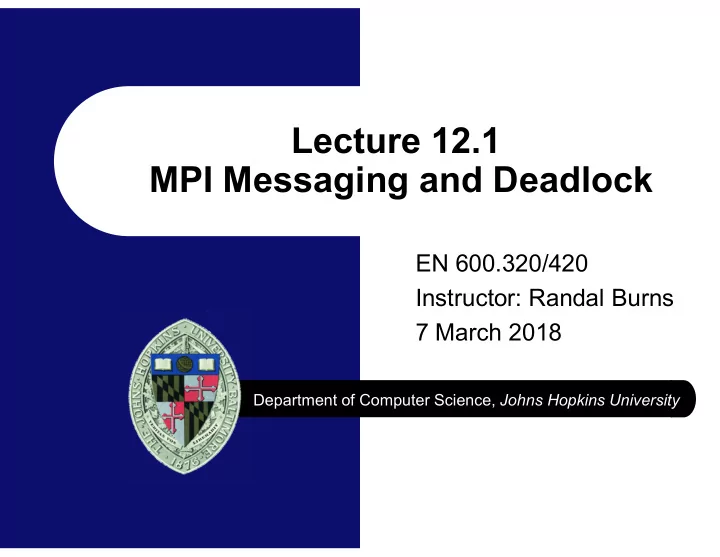

Lecture 12.1 MPI Messaging and Deadlock EN 600.320/420 Instructor: Randal Burns 7 March 2018 Department of Computer Science, Johns Hopkins University
Point-to-Point Messaging This is the fundamental operation in MPI – Send a message from one process to another Blocking I/O – Blocking provides built in synchronization – Blocking can lead to deadlock Send and receive, let ’ s do an example See nodeadlock.c Lecture 6: MPI
What’s in a message? First three arguments specify content int MPI_Send ( void* sendbuf, int count, MPI_Datatype datatype, int dest, int tag, MPI_Comm comm ) Lecture 6: MPI
What’s in a message? First three arguments specify content int MPI_Recv ( void* recvbuf, int count, MPI_Datatype datatype, int source, . . . ) All MPI data are arrays – Where is it? – How many? – What type? Lecture 6: MPI
MPI Datatypes Lecture 6: MPI
Deadlock Conditions for deadlock – Mutual exclusion http://en.wikipedia.org/wiki/Deadlock – Hold and wait – No preemption – Circular wait Deadlocks are cycles in a resource dependency graph Lecture 6: MPI
Deadlock in MPI Messaging Synchronous: the caller waits on the message to be delivered prior to returning – So why didn’t our program deadlock? See deadlock.c Lecture 6: MPI
Deadlock in MPI Messaging Synchronous: the caller waits on the message to be delivered prior to returning – So why didn ’ t our program deadlock? Blocking standard send may be implemented by the MPI runtime in a variety of ways – MPI_Send( …, MPI_COMM_WORLD ) – Buffered at sender or receiver – Depending upon message size, number of processes Converting to a mandatory synchronous send reveals the deadlock – MPI_Ssend( …, MPI_COMM_WORLD ) – But so could increasing the # of processors Lecture 6: MPI
Standard Mode MPI runtime chooses best behavior for messaging based on system/message parameters: – Amount of buffer space – Message size – Number of processors Preferred way to program?? – Commonly used and realizes good performance – System take available optimizations Can lead to horrible errors – Because semantics/correctness changes based on job configuration. Dangerous! Lecture 6: MPI
Standard Mode Danger You develop program on small cluster – Has plenty of memory for small instances – Messages get buffered which hides unsafe (deadlock) messaging protocol You launch code on big cluster with big instance – Bigger messages and more memory consumption means that MPI can’t buffer messages – Standard mode falls back to synchronous sends – Your code breaks Best practice: test messaging protocols with synchronous sends, deploy code in standard mode Lecture 6: MPI
Avoiding Deadlock Conditions for deadlock – Mutual exclusion – Hold and wait http://en.wikipedia.org/wiki/Deadlock – No preemption – Circular wait Deadlocks are cycles in a resource dependency graph Avoiding deadlock in MPI – Create cycle-free messaging disciplines – Synchronize actions See passitforward.c Lecture 6: MPI
Messaging Topology Pair sends and receives – No circular dependencies – Relies on/assumes even number of nodes! See passitforward.c Lecture 6: MPI
Messaging Topologies Order/pair sends and receives to avoid deadlocks For linear orderings and rings – Simplest and sufficient: (n-1) send/receive, 1 receive/send – More parallel, alternate send/receive and receive/send For more complex communication topologies? Messaging topology dictates parallelism – Important part of parallel design Lecture 6: MPI
Recommend
More recommend